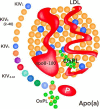Lipoprotein(a) in patients with breast cancer after chemotherapy: exploring potential strategies for cardioprotection
- PMID: 37736722
- PMCID: PMC10515253
- DOI: 10.1186/s12944-023-01926-9
Lipoprotein(a) in patients with breast cancer after chemotherapy: exploring potential strategies for cardioprotection
Abstract
Developments in neoadjuvant and adjuvant chemotherapy (CHT) have led to an increase in the number of breast cancer survivors. The determination of an appropriate follow-up for these patients is of increasing importance. Deaths due to cardiovascular disease (CVD) are an important part of mortality in patients with breast cancer.This review suggests that chemotherapeutic agents may influence lipoprotein(a) (Lp(a)) concentrations in breast cancer survivors after CHT based on many convincing evidence from epidemiologic and observational researches. Usually, the higher the Lp(a) concentration, the higher the median risk of developing CVD. However, more clinical trial results are needed in the future to provide clear evidence of a possible causal relationship. This review also discuss the existing and emerging therapies for lowering Lp(a) concentrations in the clinical setting. Hormone replacement therapy, statins, proprotein convertase subtilisin/kexin-type 9 (PCSK9) inhibitors, Antisense oligonucleotides, small interfering RNA, etc. may reduce circulating Lp(a) or decrease the incidence of CVD.
Keywords: Cardiovascular disease; Lipoprotein(a); Measurements; PCSK9 inhibitors.
© 2023. BioMed Central Ltd., part of Springer Nature.
Conflict of interest statement
The authors declare no competing interests.
Figures
Similar articles
-
Existing and emerging strategies to lower Lipoprotein(a).Atherosclerosis. 2022 May;349:110-122. doi: 10.1016/j.atherosclerosis.2022.04.020. Atherosclerosis. 2022. PMID: 35606071 Review.
-
Clinical Trial Design for Lipoprotein(a)-Lowering Therapies: JACC Focus Seminar 2/3.J Am Coll Cardiol. 2023 Apr 25;81(16):1633-1645. doi: 10.1016/j.jacc.2023.02.033. J Am Coll Cardiol. 2023. PMID: 37076218 Review.
-
Effect of atorvastatin, cholesterol ester transfer protein inhibition, and diabetes mellitus on circulating proprotein subtilisin kexin type 9 and lipoprotein(a) levels in patients at high cardiovascular risk.J Clin Lipidol. 2018 Jan-Feb;12(1):130-136. doi: 10.1016/j.jacl.2017.10.001. Epub 2017 Oct 12. J Clin Lipidol. 2018. PMID: 29103916 Clinical Trial.
-
Lipoprotein(a) and proprotein convertase subtilisin/kexin type 9 inhibitors.Clin Res Cardiol Suppl. 2019 Apr;14(Suppl 1):45-50. doi: 10.1007/s11789-019-00099-z. Clin Res Cardiol Suppl. 2019. PMID: 30838555
-
Apolipoprotein(a) phenotype determines the correlations of lipoprotein(a) and proprotein convertase subtilisin/kexin type 9 levels in patients with potential familial hypercholesterolemia.Atherosclerosis. 2018 Oct;277:477-482. doi: 10.1016/j.atherosclerosis.2018.08.011. Atherosclerosis. 2018. PMID: 30270088
References
-
- Kronenberg F, Utermann G. Lipoprotein(a): resurrected by genetics. J Intern Med. 2013;273(1):6–30. - PubMed
-
- McLean JW, Tomlinson JE, Kuang WJ, Eaton DL, Chen EY, Fless GM, et al. cDNA sequence of human apolipoprotein(a) is homologous to plasminogen. Nat. 1987;330(6144):132–137. - PubMed
-
- Tada H, Kawashiri MA, Yoshida T, Teramoto R, Nohara A, Konno T, et al. Lipoprotein(a) in familial hypercholesterolemia with proprotein convertase subtilisin/kexin type 9 (PCSK9) gain-of-function mutations. Circ J. 2016;80(2):512–518. - PubMed
Publication types
MeSH terms
Substances
Grants and funding
LinkOut - more resources
Full Text Sources
Medical
Miscellaneous




